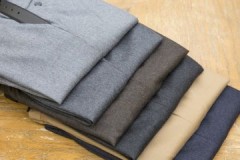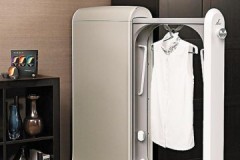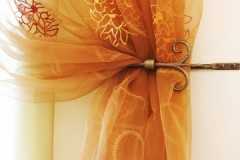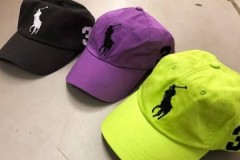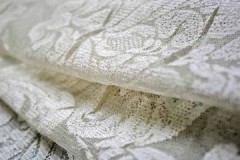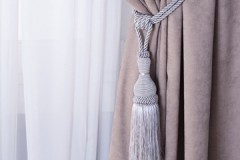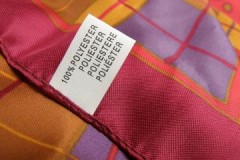 Modern technology has made the ironing process much easier. But, it is important not only to iron the fabric, but also to follow simple but useful recommendations that will save time and not cause harm to the clothes.
Modern technology has made the ironing process much easier. But, it is important not only to iron the fabric, but also to follow simple but useful recommendations that will save time and not cause harm to the clothes.
There are many interesting secrets that, when applied in practice, can extend the life of linen and even give old wardrobe items a new shine and well-groomed look.
Content
- Basic methods
- Preparing laundry: at what temperature and in what mode should you iron?
- How to iron clothes correctly?
- Features for different types of fabrics
- The purpose of gauze, why and when is it recommended to be used?
- Is it possible to iron without an iron?
- Secrets for different wardrobe items
- How much does home service cost?
- Useful tips and advice
- A few words in conclusion
Basic methods
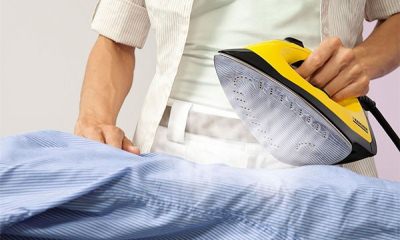 It doesn’t matter what household appliance the housewife uses for ironing, the main thing is to follow some rules and the ironing process will be significantly simplified.
It doesn’t matter what household appliance the housewife uses for ironing, the main thing is to follow some rules and the ironing process will be significantly simplified.
To give products a neat appearance, one of the following methods is used:
- Dry. Garments are ironed from the face or back.
- Wet. Eliminating creases using this method is quite simple.
- With steam mode. The best solution for stale, heavily wrinkled wardrobe items.
Not all things can be steamed, so as not to cause harm to them. It is better to check how they react to the chosen ironing method on an inconspicuous area of the fabric.
Preparing laundry: at what temperature and in what mode should you iron?
It will only take 10-15 minutes to prepare, but it will save more effort and time. First you need to carefully read the information on the tag. It indicates the possibility of using steam and temperature.
Below you can see the icons ironing:
- Ironing and steaming of products is permitted.
- Recommended mode 110?.
- Allowed to use medium mode up to 150?.
- It is permissible to use an iron heated to 200?.
- Do not steam, take it to dry cleaning.
- Do not iron.
For clarity, the icons are shown in the photo below:

If there is no label, then you need to choose a mode depending on the composition of the fabric:
- linen – 190-230?;
- cotton products – 165-190?;
- woolen items - minimum temperature - 140, maximum - 165?;
- pure silk – 115-140?;
- things made of viscose - from 85 to 115?.
How to iron clothes correctly?
Sort clothes into separate piles depending on the recommended t?. This is necessary so as not to constantly switch the thermostat. The soleplate of the iron should be clean, as should the steam chamber.
Simple instructions for ironing:
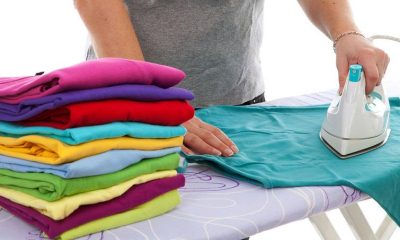 It is better to pass clothes from the inside out.
It is better to pass clothes from the inside out.- When ironing from the face, it is better to use gauze or cotton cloth soaked in water.
- Plain water is suitable for hydration.
- Clothes are laid out carefully so that there are no folds or creases.
- The light should fall from the left side - for a right-handed person.
- It is better to carefully fold sheets and duvet covers into 4 folds to avoid distortions and iron them away from the face.
- The iron is moved away from you, this will prevent burns.
- To prevent the seams from being imprinted on the face, it is better to place thin cardboard between them; the same applies to pockets.
- Iron clothes along the main line, even if the item is cut on the bias.
- Products are smoothed from top to bottom to avoid deformation.
- First, small parts of clothing are processed.
- Thick areas are carefully ironed through gauze.
- If there is lint, iron it in its direction.
Features for different types of fabrics
Before ironing the product, you should carefully study the information on the tag. If it is not there, then you can use simple rules for caring for certain types of fabrics:
-
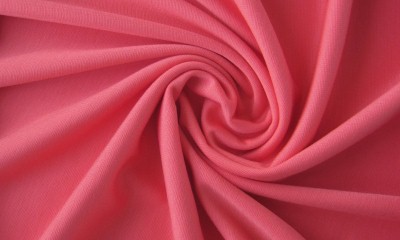 Viscose. You need to pass the iron over the material from the wrong side. Before work, carefully straighten the clothes to avoid wrinkles.
Viscose. You need to pass the iron over the material from the wrong side. Before work, carefully straighten the clothes to avoid wrinkles.Do not leave the iron on an uneven surface, as this may damage the material. It is recommended to iron through damp gauze or cotton cloth.
- Linen and cotton. Products are ironed from the inside out. It is better to wrap linen or cotton clothes in a wet cloth and leave for half an hour. Treat the surface through gauze.
It is better to use the steam function without overheating the iron to a temperature above 200 °C. For thin 100% cotton, a temperature of 160-180 °C is suitable.
- Fatin. The main thing is that the product must be washed correctly, the recommended spin is 500 rpm. It is difficult to iron a thing with a simple iron. A dense material is placed under the fabric, with cotton fabric or gauze on top. Choose the minimum t °C, otherwise the clothes will turn yellow. You can use the steam function, which straightens the item without deforming it.
- Velvet and corduroy products. In the second case, steam is used. Velvet items are ironed from the inside out through cotton fabric. It is better to place a terry towel of small thickness on the ironing board. This preserves the appearance of the clothes. Iron corduroy and velvet at low temperature.
- Jack. First, iron the item off your face. There should be no creases on the reverse side. It is very difficult to eliminate them. Fold the product in half, facing inward. Treat on one side, then on the other at a temperature of t °C 200-210.
- Synthetics. Practical, popular fabric. You can iron such products by following the recommendations indicated on the label: ironing and washing mode. Most often, low or medium temperature is used. Products are processed from the inside out through gauze or cotton fabric.
- Veil. Before you start working, it is better to apply gauze to your clothes. Without cotton fabric, ironing the product should not be done. It is also impossible to linger in one place - you can damage the material. The iron must be moved quickly and carefully. Steam use is also not recommended.
-
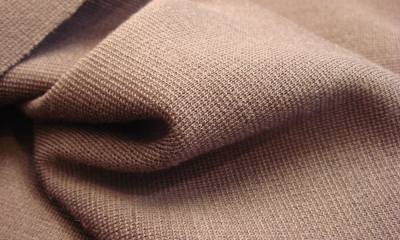 Knitwear. Knitted items may become deformed after washing. Iron from the inside out, the fabric should be damp.
Knitwear. Knitted items may become deformed after washing. Iron from the inside out, the fabric should be damp.It is better to move the device carefully over the material. Ironed clothes should be left on the ironing board to cool and dry thoroughly.
- Capron. You can iron it, but only at a low temperature of 110°C. If your device doesn't have a gentle mode, it won't work. Align the nylon well on the board, put cotton fabric on top. The more delicate the item, the thicker the padding should be. The steam function cannot be used.
- Satin. It is recommended to treat the product from the face. Set the mode to 200°C. For effective ironing, you can use a steamer. But the fabric itself needs to be dried well. Wet material will stretch and deform. Additional fabric pads, gauze is not used.
- Atlas. Products quickly wrinkle and become deformed. They should be a little damp. Temperature range 140-150°C. The regulator should be set to “silk” mode. It is better to treat the surface from the inside out through cotton fabric. Move the device quickly, without holding it in one position, otherwise the structure of the fibers will be disrupted.
- Tulle. Recommended temperature 120°C.Most curtains can be steamed. If there is no such function, place a damp cloth on the ironer. Read more Here.
- Organza. Place gauze under the material. Set the minimum temperature. You can use the steam function. You can find detailed information Here.
- Polyester. Iron from the inside out through moistened gauze. If the item remains wrinkled on the front side, you will have to go over it too. Temperature 120-130°C. Read more Here.
-
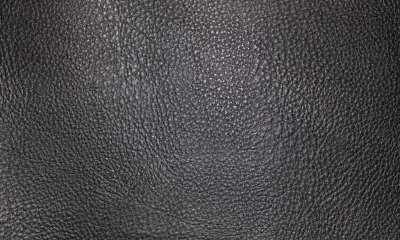 Leatherette. When ironing, the areas should not touch. It is better to place a roller in the sleeve. Treat the surface from the wrong side through gauze.
Leatherette. When ironing, the areas should not touch. It is better to place a roller in the sleeve. Treat the surface from the wrong side through gauze.The temperature is minimal, steam cannot be used. Read more Here.
- Leather. Temperature range 110-140°C. First straighten the product well. Read more Here.
- Silk. Select a mode with the same name. Place moistened gauze on the front side (if the product is completely dry). The steam mode cannot be turned on. Read more Here.
Not all linen and cotton fabrics are natural. Manufacturers often add synthetic fibers, which reduce the cost of products; they are ironed at lower temperatures and wrinkle less. To avoid damaging your clothing, you should read the fabric composition on the label.
The purpose of gauze, why and when is it recommended to be used?
Thin cotton fabric is the best way to protect shiny and delicate products. It is recommended to use gauze for ironing dark clothes that show streaks after ironing.
A few tips on how to properly use cotton fabric:
- If the item has dried, it is recommended to pre-moisten the cushioning material.
- It is good to steam the folds through gauze.
- To give clothes a bright color, gauze fabric can be slightly soaked in vinegar.
Before moving on to another piece of clothing, you should check how the material has been ironed under the cotton fabric.
Is it possible to iron without an iron?
You can make things look well-groomed in different ways. Even a high-quality iron can fail at the most crucial moment, so it is important to know alternative methods, how to iron things without an iron:
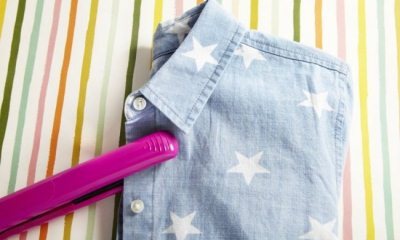 a bathtub filled with hot water;
a bathtub filled with hot water;- moistened terry towels: lay out clothes on one, straighten, cover with the other;
- boiling kettle: the item is ironed with steam;
- vinegar and water: spray the product well;
- hair dryer: clothes are moistened, smoothed, then dried;
- An iron is an ideal tool for ironing collars.
Ironing cabinet Can handle any material. It will help get rid of even large creases, stretch the product after washing, make creases on your trousers. Such devices allow you to iron curtains and outerwear while hanging, eliminating the appearance of wrinkles.
Secrets for different wardrobe items
Not all clothing items are cared for equally. Each thing requires a separate approach. To get the maximum effect from your work, you need to follow simple rules.
| Wardrobe item | Some useful tips |
| Trousers | From the wrong side, iron folds, pockets, seams. Turn the trousers inside out and iron the top, waistband, inside, then outside. |
| Jeans | Most often, such products are simply straightened after washing to maintain their original appearance. If you need to go through the iron, you need to do it from the inside out. |
| Coat | Such wardrobe items cannot be ironed. They need to be steamed by weight. |
| Cloak | The processing method depends on the fabric. The raincoat is ironed from the inside and then from the outside. |
| Blazer | Iron the lining on the sleeves, then the sleeves themselves using a special board. Next is the back, floors, collar, lining and sides of the product. |
| Kids' things | Iron from the inside at maximum temperature. |
| Skirts | First iron the back side, then the face. Pull the lining out, iron the panels as usual using cotton fabric. |
| Shirts | You need to start with the sleeves. The cuffs are ironed from the inside, then the collar, the top of the back, and the front of the product. |
| Bed dress | Fold the product 4 times. The fabric should be damp. The temperature depends on the material. |
| Jacket | Turn inside out, select “silk” mode. To avoid damaging the fabric, use gauze. |
| Curtains And curtains | Products are ironed wet at a temperature of 110-130 degrees. Quick, careful movements. |
| Cap | Moisten the baseball cap and put it on the frame. Straighten the fabric well. Leave until completely dry. |
| T-shirts | Iron small parts after the sleeve to create arrows on the bend. Iron the back and shelves. |
| Paper | Lay out well, cover with a cloth, select the minimum temperature. During the ironing process, gradually increase it. |
Here are simple tips for caring for things that will help you maintain the original appearance of your clothes and always look respectable.
How much does home service cost?
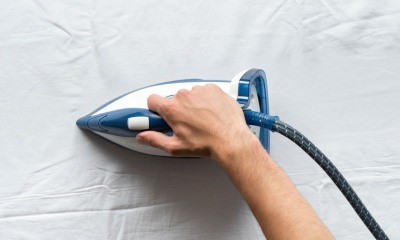 A popular service that allows you to give your product a well-groomed, pleasant look.Ironing is performed using special equipment that acts delicately on the material, eliminating unevenness and creases.
A popular service that allows you to give your product a well-groomed, pleasant look.Ironing is performed using special equipment that acts delicately on the material, eliminating unevenness and creases.
Specialists work individually:
- the degree of wear and structure of the material are assessed;
- the manufacturer's care advice is taken into account;
- the optimal temperature is selected.
The cost of professional ironing depends on the size, number of items, and type of material. The average price is 1700-2000 rubles.
Useful tips and advice
A few simple recommendations:
- The surface of the equipment must be clean.
- Only boiled water should be poured into the tank.
- It is better to purchase a large ironing iron.
- Before work, you should prepare hangers to hang clothes on.
- Treat stains remaining after ironing with peroxide.
- Glimpses can be removed with a simple wet cloth.
- Items that are not dry cannot be ironed; they will remain stained.
A few words in conclusion
 There are different ways to care for individual wardrobe items. When choosing the temperature and ironing option, the composition of the fabric is taken into account. Before use, you should read the label carefully.
There are different ways to care for individual wardrobe items. When choosing the temperature and ironing option, the composition of the fabric is taken into account. Before use, you should read the label carefully.
Things should not be wet, just slightly damp; a yellow stain may remain on the product.
It is not recommended to store clothes for a long time after washing - stains will appear and the laundry will be difficult to iron.
By following simple recommendations, you can not only simplify the work, but also reduce the time spent on it.. When you are busy, you can use the services of professionals.
